Today, a disease such as osteochondrosis of the chest and cervical spine is considered to be quite common among people of different ages.

A sedentary lifestyle, poor posture and wearing uncomfortable shoes can lead to a very serious illness that is impossible to diagnose in the early stages.
Features of thoracic osteochondrosis
Osteochondrosis of the thoracic spine, most commonly called thoracic chondrosarcoma, is a disease of the intervertebral discs of the thoracic spine. Also, thoracic osteochondrosis is called "chameleon" because the symptoms are not immediately apparent and can be mistaken for a completely different disease.
Often the disease is caused by metabolic disorders, as well as excessive stress on the intervertebral discs. Thoracic chondrosis disrupts the normal functioning of the intervertebral disc.
Unlike other types, thoracic osteochondrosis is less pronounced and has the following symptoms:
- Painful pain in the chest,is exacerbated at night by more severe dizziness or hypothermia.
- Pain between shoulder bladeswith sharp rise or sharp bending of the joint.
- severe pain when sighingand a feeling of tightness in the chest.
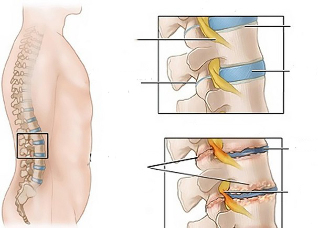
The above symptoms refer to the early stages of the disease.
The following symptoms may appear with a long course without medical intervention:
- Inconsistency in small areas of skin.
- Itching or burning in the legs.
- Severe skin peeling.
- Mild pain in the throat or esophagus.
- Poor gastrointestinal function.
Cervical lumbar osteochondrosis
Osteochondrosis of the cervical spine or cervical chondrosis is a disease that weakens the intervertebral discs and causes changes in the discs themselves and the structure of the cervical joints. Nerve endings can be inflamed by compression by destructive intervertebral discs.
According to the International Classification of Diseases (ICD-10), M42. It has the code 02.
The following pain sensations are characteristic of the disease:
- Periodic headaches.
- Periodically aching pain in the neck, back, shoulders.
- Short-term vision impairment.
- Reduces the sensitivity of the collar area.
Symptoms of cervical chondrosis

The second degree is characterized by the appearance of small spinal hernias and the following symptoms:
- Cervical back pain, a strong tingling in a sharp curve of the head.
- Periodic loss of sensitivity in the arms and shoulders.
- Visual disturbances and recurrent noise in the ears, sleep problems.
- Convergence of the face and neck, weakening of the upper extremities.
- Periodic sharp pain in the shoulder blades.
The third stage of cervical osteochondrosis is difficult to treat. The size of the intervertebral hernia increases, there is a deformation of the spine.
The following symptoms will appear for the third stage:
- Severe pain in the neck and heart.
- Loss of sensitivity in the scalp, arms, shoulders.
- Paralysis of the upper limbs.
- Cervical vertebral hernia.
The fourth stage is characterized by exacerbation of all the above symptoms.
Symptoms of cervicothoracic osteochondrosis
A fairly common disease that immediately affects the cervical and thoracic regions. Lumbar injuries can start at any age due to a sedentary lifestyle and excess weight. Hereditary factors and work play an important role in hazardous production (excessive vibration).
According to ICD-10, this type of osteochondrosis has the code M 42. 02.
Symptoms of cervicothoracic osteochondrosis include:
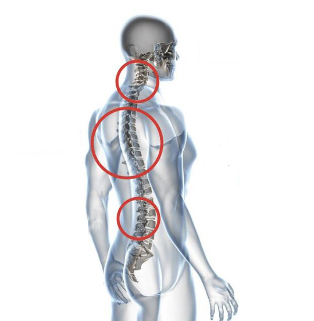
- Sudden dizziness.
- Painful pain in the neck and shoulders.
- Pain in the right hypochondrium.
- Blood pressure drops and tachycardia.
Osteochondrosis with radicular syndrome
The disease got its name due to dysfunction in the roots of the intervertebral nerves.
When the roots are affected, a number of untidy symptoms develop, including sharp "shooting" pains in the back and neck.
Symptoms include:
- Short-term loss of ability to perform any action.
- Loss of sensation in the limbs.
- Muscle malnutrition.
- Changes in neurological reflexes (detected by a neurologist).
The following factors are associated with the development of radicular syndrome:
- Excess weight, pregnancy, uneven load on the spine when wearing uncomfortable shoes.
- Asymmetry of lower extremities, straight legs.
- Injuries, sharp loads on the spine.
If the disease is detected at an early stage, surgery is not required.
Causes of cervical osteochondrosis
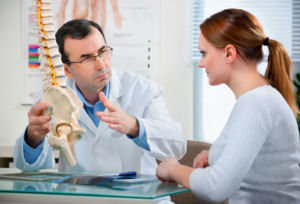
The main causes of osteochondrosis:
- Heavy weight and sedentary work, sedentary lifestyle.
- Previous spinal injuries and curvature of the spine.
- Stress and nervous tension.
- Lack of physical fitness.
- Lack of healthy nutrition.
Degrees of osteochondrosis of the chest and cervical region
The development of cervical osteochondrosis is characterized by the following stages of the disease:
- The first stageis characterized by changes in the intervertebral discs. Changes begin to occur due to the loss of fluid reserves from the nucleus of the intervertebral discs. The pain is not felt yet.
- In the second stage,the intervertebral discs are flattered. As a result, there are strong loads in the joints and muscles that begin to coalesce due to the constant heavy load. Constant dizziness is characteristic.
- Third stageSignificant changes in bone and cartilage tissue are characterized by the appearance of osteoarthritis.
- The fourth stageis characterized by the appearance of bone growths in the vertebrae.
Diagnostics
The first step in diagnosing osteochondrosis is a complete examination of the spine. In the early stages, the symptoms of osteochondrosis can be confused with a number of other diseases. Diagnosis should be performed by a highly qualified specialist.
To diagnose the disease, you should contact the attending physician who will refer you to a narrower profile specialist. The sooner the patient seeks medical help, the faster and safer the treatment will be.
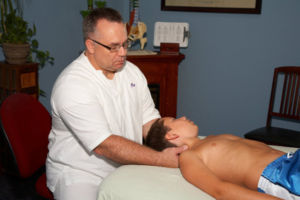
In fact, osteochondrosis is not treated by one specialist, but by several people:
- Radiologist.After receiving X-ray results, the picture of the disease will become clearer.
- Chiropractor. Determines the exact location and stage of the disease.
- The doctor is an osteopath.The treatment is very similar to manual therapy.
- Doctor - neurologist.Osteochondrosis is closely related to diseases of the nervous system. The doctor will help to treat the disease in both the first and second stages.
- Doctor - physiotherapist.He specializes in physiotherapy exercises. Physical training helps only in the early stages of the disease.
Acute exacerbation of the disease is considered quite common. In such cases, you should immediately consult a neurologist. Osteochondrosis of both the cervical, thoracic and lumbar regions is closely related to neurological disease. The neurologist will prescribe a course of medication to relieve the pain.
Osteochondrosis in women during pregnancy and breastfeeding
Osteochondrosis during pregnancy is a common phenomenon, because during pregnancy a woman is exposed to a global restructuring and a very strong load on the whole body. Disease in the fetus has no effect, but can cause a number of serious problems during childbirth.
To reduce the tension in the spine, it is recommended that a doctor monitor the breastfeeding period and wear a corrective corset.
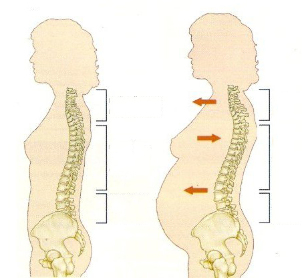
The causes of osteochondrosis during pregnancy are:
- Lose weight and wear heavy stress and uncomfortable shoes on your spine.
- Childhood pressure on neighboring organs.
- Changes in hormonal levels.
- Deficiency of useful vitamins and minerals.
- Rest and lack of sleep, various stresses.
To prevent the disease, you should consult a doctor at the first signs of anxiety. You should not wait for the pregnancy to end. The disease can develop after birth and will be much more difficult to treat.
If a disease is detected, the pregnant woman will be instructed to wear a prenatal bandage, a course of vitamins and minerals, as well as special gymnastics.
First aid for exacerbation of osteochondrosis at home
The duration of exacerbation depends on the type of disease and the degree of indifference. Inflammation can often last from 1 week to 1 month.
Attention! Prohibited in case of exacerbation of the disease: warming in the bath or any other heating, massage and self-treatment.
In the event of a sudden attack, you should do the following before the doctors arrive:
- Give the patient maximum rest.
- If possible, place the patient in a firm position.
- Apply a cool compress to the affected area.
- Apply anti-inflammatory ointment to the affected area.
If it is not possible to contact a specialist in the near future, you should take the following actions:
- Take a warm, comfortable shower.
- Do not make sudden movements.
- Do not lift weights.
- Keep your neck stable to avoid further compression.
Dorsago and dorsalgia
Dorsagois the name of one of the signs of inflammation of the spine. Dorsago is characterized by severe pain in the heart region, most often occurring in people who work monotonously or after prolonged restlessness. Short-term shortness of breath is possible with sudden movements.
Dorsalgiais a pain syndrome that lasts for about 2 weeks and occurs with acute exacerbation of the disease. Pain with dorsalgia gradually increases. The pain is especially severe when leaning forward or breathing deeply. Often, pulling pain occurs in the shoulder blades, lumbar region.
Treatment of cervical and thoracic osteochondrosis
Different methods of treating osteochondrosis are used in case of a disease.

The most common are:
- Physiotherapy- paraffin compresses, magnetic therapy, laser therapy.
- Physiotherapygymnastics and massage.
- Reflexology- treatment is performed using needles that affect the affected areas. It is necessary to consult a specialist before starting treatment, as there are a number of contraindications.
- Folk remediesand diet.
- Medication- prescribed by a specialist only after a thorough examination.
Medication
Most doctors prescribe medication to relieve back pain. As the stage progresses, medications relieve pain for a short time. Therefore, doctors prescribe NSAIDs in tablet or capsule form to relieve pain and further inflammation.
Chondoprotectorsis another type of medication prescribed for osteochondrosis. The drugs are designed to protect and strengthen bone and cartilage tissue from destruction.
During a severe inflammatory process in muscle tissue, the patient will be prescribed medication to relieve muscle spasms.
Dosage should be determined by the attending physician. The drug should not be taken for more than 3 weeks.
One of the most effective methods of drug treatment is the use of needles that can reduce pain.
Fixation means
In case of complex treatment, the patient may be advised to wear special fixation corsets and bandages.
Exercises for Osteochondrosis
Exercises prescribed in the physiotherapy room can not only relieve pain, but also strengthen the spinal muscles, which prevents the development of any complications. Also, after several courses of physiotherapy, the posture improves significantly.
Well-known doctor Bubnovsky has developed a number of exercises that can be used at home to treat osteochondrosis.
The most common exercises are:
- Walk, lift arms and legs smoothly.
- Rotation of the shoulders in different directions, bringing and extending the shoulder blades.
- Slowly bends to the side.
- Stretching exercises for the spine and neck muscles.
- Bending of arms and legs.
Dizziness is prohibited with cervical osteochondrosis, as it can cause a complication of the disease.
Physiotherapy treatments
Physiotherapy is mainly aimed at reducing back pain. The procedure improves blood circulation and enriches muscles with oxygen.

The most common physiotherapy procedures today are:
- Vibrating massage- helps to get rid of compressed nerves in the intervertebral discs. Contraindications - pregnancy, high blood pressure.
- Acupuncture- relieves pain. It also helps to relax your back muscles. Contraindications epilepsy.
- Electrotherapy- the method consists in weakening the affected areas of the spine. Contraindications are heart disease.
- Ultraviolet- enriches the body with vitamin D, which absorbs calcium faster. It also has an anti-inflammatory effect on the affected area. Contraindications to the procedure are blood diseases, allergic skin reactions, the presence of cancer.
Treatment of osteochondrosis with folk remedies
In the complex treatment of the disease, some doctors recommend the use of folk remedies to eliminate the disease. It is especially important to observe the correct dose and method of treatment in complex treatment.
Home remedies relieve pain in the muscles and joints and restore joint mobility:
- Fir and turpentine ointment.150g. Melt 1 tablespoon of any oil of animal origin in a water bath. fir oil and turpentine. After 20 minutes, remove the ointment from the oven, allow to cool and apply only to the affected areas of the lower back.
- mustard compress.Combine mustard powder, vodka and camphor alcohol in equal amounts. After mixing thoroughly, add 4 egg whites. Infuse the mixture for 4 hours. Apply a compress to the affected areas.
- Turpentine bath.Shake the solution vial well. Then pour 5 ml of emulsion in a hot bath. In subsequent periods, the solution can be increased to 10-15 ml. You should spend 20 minutes in such a bath. The water temperature should not exceed 40 degrees. It is also necessary to ensure that the water does not reach the heart area.
Treatment of osteochondrosis according to Valentin Dikula
This technique is very common in the treatment of the disease. Valentin Ivanovich Dikul first tried his method. Dikul's technique is indicated for spinal and intervertebral hernias.
The following principles should be followed when exercising:
- Compliance with the sequence of exercises.
- Gradually load your body with exercise.
- Permanent performance.
- Exclude fast workouts, the technique involves smooth and slow movements.
Nutrition principles for osteochondrosis

In case of complex treatment, a special diet should be followed:
- Drink plenty of water.
- Food contains enough vitamins and minerals.
- Eat foods rich in protein and calcium.
diet implies an exception:
- Fried, fatty and spicy foods.
- Refuse fast snacks (sandwiches, fast food).
- Avoid eating for a few hours before bedtime.
Preventive measures
The following precautions should be used to prevent or stop the development of the disease:
- Always watch your posture, do yoga or exercise in the morning.
- Limiting the sharp load on the spine.
- Limit shaking movements.
- Avoid uncomfortable shoes, as well as high-heeled shoes.
- Equal distribution of the load on the spine when performing any work.
Result
In addition to properly following all the above recommendations, almost any disease can be treated by timely consultation with specialists. Treatment of osteochondrosis takes a lot of time and money, but an advanced disease can cause a wheelchair.



































